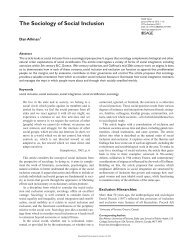Inclusive Education for Learners With Disabilities in ... - SAGE Open
Inclusive Education for Learners With Disabilities in ... - SAGE Open
Inclusive Education for Learners With Disabilities in ... - SAGE Open
You also want an ePaper? Increase the reach of your titles
YUMPU automatically turns print PDFs into web optimized ePapers that Google loves.
2 <strong>SAGE</strong> <strong>Open</strong>to prepare children with special educational needs <strong>for</strong>social <strong>in</strong>tegration by <strong>in</strong>tegrat<strong>in</strong>g them as far as possiblewith their peers <strong>in</strong> ord<strong>in</strong>ary schools.to ensure a comprehensive assessment that is based onthe child’s learn<strong>in</strong>g needs, and not on group norms,and which is followed by <strong>in</strong>dividualized <strong>in</strong>struction.to promote the early identification and <strong>in</strong>terventionwhich will ensure the maximum success of the rehabilitationprocess.to ensure the support and active participation of thechildren’s parents and community through an educationand <strong>in</strong><strong>for</strong>mation campaign. (Government ofBotswana, 1994, p. 38)Two other key recommendations are worth not<strong>in</strong>g. First,each school has a senior teacher who is responsible <strong>for</strong> learnerswith special educational needs and who will coord<strong>in</strong>ate aschool <strong>in</strong>tervention team. Second, all teachers have elementsabout special needs education as a part of their preservice or<strong>in</strong>-service tra<strong>in</strong><strong>in</strong>g.Practice of <strong>Inclusive</strong> <strong>Education</strong> <strong>in</strong> BotswanaAlthough <strong>in</strong>clusive education has been rapidly ga<strong>in</strong><strong>in</strong>gacceptance <strong>in</strong> Botswana academic circles, government texts,and mass media, there is a lack of shared understand<strong>in</strong>g ofthe implication of the concept, as neither the government noracademics have been able to engage critically with the mean<strong>in</strong>gsand relevance of the concept with<strong>in</strong> the context ofBotswana (Mukhopadhyay, 2009). Empirical studies <strong>in</strong> thisarea have been scarce and the small amount of exist<strong>in</strong>g publishedliterature largely consists of personal op<strong>in</strong>ions. Thelimited research (Gaotlhobogwe, 2001; Masimega, 1999)that is available <strong>in</strong> Botswana has concentrated on the <strong>in</strong>clusionof learners with specific categories of disabilities.Researchers (Brandon, 2006; Mangope, 2002) exam<strong>in</strong>edattitudes of Botswana teachers toward <strong>in</strong>clusive education andfound that teachers held nonfavorable attitudes toward <strong>in</strong>clusiveeducation. In addition, synthesis of these research studiesalso <strong>in</strong>dicates a gap between recommended practice and thereality of implementation of <strong>in</strong>clusive education. However,most studies have focused on teachers’ perspectives and haveignored other critical stakeholders’ <strong>in</strong>volvement <strong>in</strong> the process,such as learners with and without disabilities.MethodThis report is based on qualitative methods employ<strong>in</strong>g amultiple–case study approach. In the rest of this section, wedescribe the design of the research, the research sett<strong>in</strong>gs, theparticipants and participant selection process, the <strong>in</strong>terviewprocedures, and the approach to data analysis.Research DesignA multiple–case study approach was employed to ga<strong>in</strong><strong>in</strong>sights <strong>in</strong>to the practice and process of <strong>in</strong>clusive education<strong>in</strong> the South Central Regions of Botswana. Qualitativeresearch traditions are <strong>in</strong>vestigations of lived experience ofthe participants <strong>in</strong> their naturally occurr<strong>in</strong>g environments.Given the focus on multiple stakeholders’ views and experiences,it was possible to construe the methodologicalapproach of the study as phenomenological <strong>in</strong> nature. Ingeneral, phenomenological research aims at clarify<strong>in</strong>g <strong>in</strong>dividuals’situations <strong>in</strong> everyday life (Giorgi & Giorgi, 2003).In this study, the specific aspects of everyday life that wereof <strong>in</strong>terest to the researcher were the processes and practicesof <strong>in</strong>clusive education. Us<strong>in</strong>g this approach enabled theresearcher to explore the perspectives of participants and toexam<strong>in</strong>e their experiences <strong>in</strong> the contexts <strong>in</strong> which theyoccurred.Research Sett<strong>in</strong>gsSchools <strong>in</strong> the Republic of Botswana are grouped <strong>in</strong>to 10adm<strong>in</strong>istrative regions. This study was carried out <strong>in</strong>selected primary schools located <strong>in</strong> the South CentralRegion. The medium of <strong>in</strong>struction <strong>in</strong> these schools waspredom<strong>in</strong>antly English, but the local language, Setswana,was also used <strong>in</strong> the classroom <strong>for</strong> ease of understand<strong>in</strong>g.The South Central Region consists of schools <strong>in</strong> the follow<strong>in</strong>gdistricts and city council: South-East, Kgatleng,Gaborone City Council, and Kweneng. In terms of the location,the schools were categorized <strong>in</strong>to three groups, namely,urban, semiurban, and rural. Schools from each of the threegroups were selected purposively.ParticipantsThe population of government-aided primary schools of theSouth Central Regions of Botswana totaled 165 schools. Asample of schools was selected purposively from amongthose that already <strong>in</strong>cluded learners with disabilities. A totalof 6 schools were selected, 2 schools from each of threetypes of location (urban, semiurban, and rural). Initially, sixschool-heads were chosen; thereafter, learners with disabilities,their peers, and general education teachers wereselected us<strong>in</strong>g snowball sampl<strong>in</strong>g. Snowball sampl<strong>in</strong>g wasused because the potential teachers under <strong>in</strong>vestigation were“hidden,” due to low numbers of learners with disabilities <strong>in</strong>regular primary schools (Kath, 2005). Careful attention waspaid to the process of ga<strong>in</strong><strong>in</strong>g entry to the schools, selectionof <strong>in</strong><strong>for</strong>mants, develop<strong>in</strong>g and ma<strong>in</strong>ta<strong>in</strong><strong>in</strong>g rapport, andDownloaded from by guest on January 12, 2015















